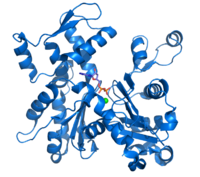
Photo from wikipedia
A common way to study the functional importance of N-methyl-D-aspartate receptors (NMDARs) in hippocampal memory-encoding circuits is by administering NMDAR antagonists. We recently compared the effects of (R,S)-3-(2-carboxypiperazin-4-yl)-propyl-1-phosphonic acid (CPP),… Click to show full abstract
A common way to study the functional importance of N-methyl-D-aspartate receptors (NMDARs) in hippocampal memory-encoding circuits is by administering NMDAR antagonists. We recently compared the effects of (R,S)-3-(2-carboxypiperazin-4-yl)-propyl-1-phosphonic acid (CPP), a competitive NMDAR antagonist, on suppression of memory in vivo versus suppression of NMDAR-mediated field EPSPs (fEPSPNMDA) and long-term potentiation (LTP) in vitro. Surprisingly, we found that concentrations that block contextual conditioning in vivo are ineffective at blocking the fEPSPNMDA or LTP in vitro. Here we tested one possible explanation for the mismatch – that the hippocampus is relatively resistant to CPP compared to other brain structures engaged in contextual fear conditioning. We used the context pre-exposure facilitation effect (CPFE) paradigm to isolate the hippocampal component of contextual learning, and in-vivo calcium imaging of place cells and spatial engrams to directly assess hippocampal spatial coding. We found that, by both measures, the active enantiomer (R)-CPP did interfere with hippocampal function at concentrations below those that block fEPSPs or LTP. We conclude that the alternative – that CPP interferes with memory by targeting NMDARs in interneurons rather than pyramidal neurons – is the more likely explanation.
Journal Title: Neuropharmacology
Year Published: 2022
Link to full text (if available)
Share on Social Media: Sign Up to like & get
recommendations!